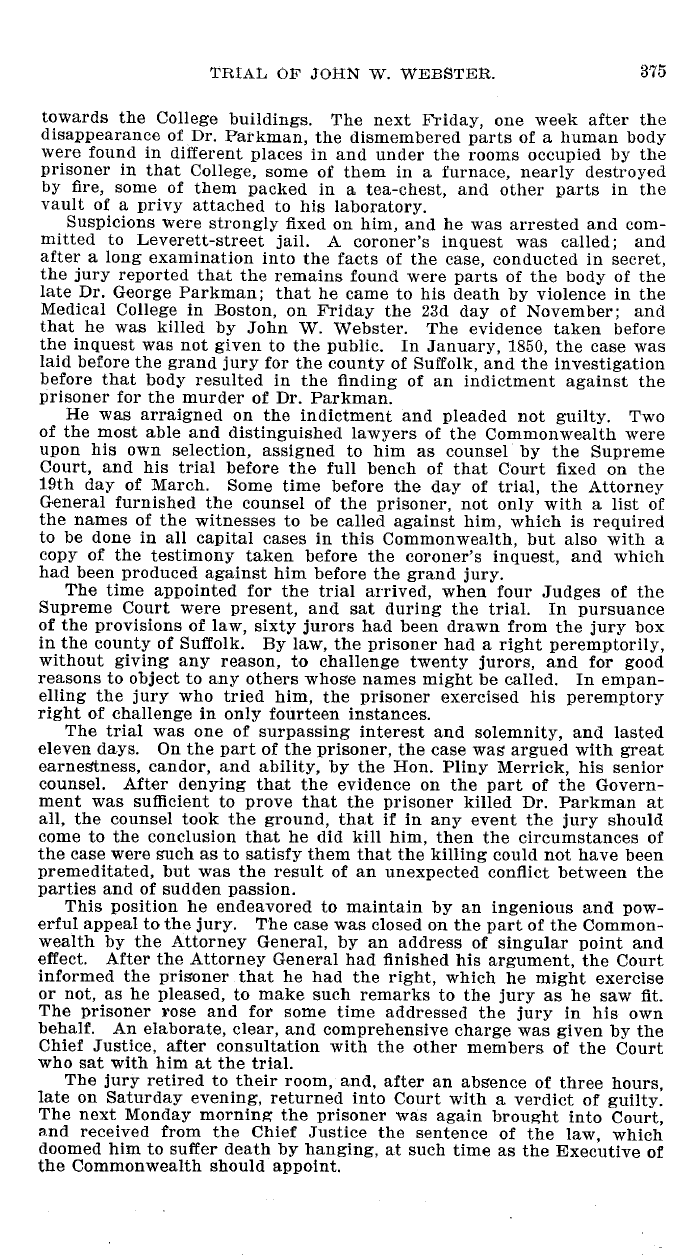|
TRIAL OF JOHN W. WEBSTER. 3'75
towards the College buildings. The next Friday, one week after the
disappearance of Dr. Parkman, the dismembered parts of a human body
were found in different places in and under the rooms occupied by the
prisoner in that College, some of them in a furnace, nearly destroyed
by fire, some of them packed in a tea-chest, and other parts in the
vault of a privy attached to his laboratory.
Suspicions were strongly fixed on him, and he was arrested and com-
mitted to Leverett-street jail. A coroner's inquest was called; and
after a long examination into the facts of the case, conducted in secret,
the jury reported that the remains found were parts of the body of the
late Dr. George Parkman; that he came to his death by violence in the
Medical College in Boston, on Friday the 23d day of November; and
that he was killed by John W. Webster. The evidence taken before
the inquest was not given to the public. In January, 1850, the case was
laid before the grand jury for the county of Suffolk, and the investigation
before that body resulted in the finding of an indictment against the
prisoner for the murder of Dr. Parkman.
He was arraigned on the indictment and pleaded not guilty. Two
of the most able and distinguished lawyers of the Commonwealth were
upon his own selection, assigned to him as counsel by the Supreme
Court, and his trial before the full bench of that Court fixed on the
19th day of March. Some time before the day of trial, the Attorney
General furnished the counsel of the prisoner, not only with a list of
the names of the witnesses to be called against him, which is required
to be done in all capital cases in this Commonwealth, but also with a
copy of the testimony taken before the coroner's inquest, and which
had been produced against him before the grand jury.
The time appointed for the trial arrived, when four Judges of the
Supreme Court were present, and sat during the trial. In pursuance
of the provisions of law, sixty jurors had been drawn from the jury box
in the county of Suffolk. By law, the prisoner had a right peremptorily,
without giving any reason, to challenge twenty jurors, and for good
reasons to object to any others whose names might be called. In empan-
elling the jury who tried him, the prisoner exercised his peremptory
right of challenge in only fourteen instances.
The trial was one of surpassing interest and solemnity, and lasted
eleven days. On the part of the prisoner, the case was argued with great
earnestness, candor, and ability, by the Hon. Pliny Merrick, his senior
counsel. After denying that the evidence on the part of the Govern-
ment was sufficient to prove that the prisoner killed Dr. Parkman at
all, the counsel took the ground, that if in any event the jury should
come to the conclusion that he did kill him, then the circumstances of
the case were such as to satisfy them that the killing could not have been
premeditated, but was the result of an unexpected conflict between the
parties and of sudden passion.
This position he endeavored to maintain by an ingenious and pow-
erful appeal to the jury. The case was closed on the part of the Common-
wealth by the Attorney General, by an address of singular point and
effect. After the Attorney General had finished his argument, the Court
informed the prisoner that he had the right, which he might exercise
or not, as he pleased, to make such remarks to the jury as he saw fit.
The prisoner rose and for some time addressed the jury in his own
behalf. An elaborate, clear, and comprehensive charge was given by the
Chief Justice, after consultation with the other members of the Court
who sat with him at the trial.
The jury retired to their room, and, after an absence of three hours,
late on Saturday evening, returned into Court with a verdict of guilty.
The next Monday morning the prisoner was again brought into Court,
and received from the Chief Justice the sentence of the law, which
doomed him to suffer death by hanging, at such time as the Executive of
the Commonwealth should appoint.
|

